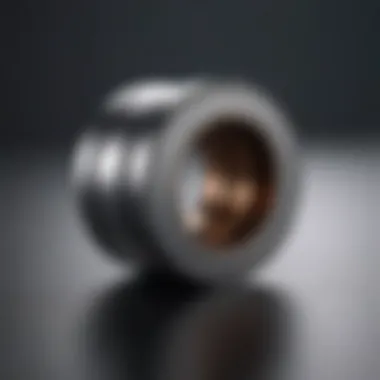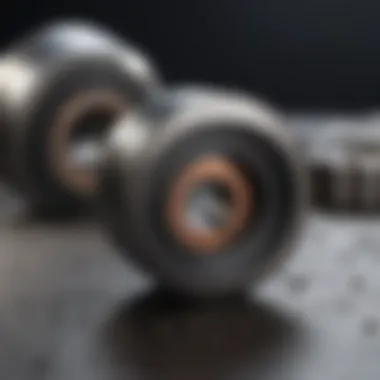Exploring Soft Iron Cores in Electromagnets


Intro
Key Findings
Major Results
The use of soft iron cores brings several specific advantages to the table. First, soft iron displays high magnetic permeability, allowing it to conduct magnetic fields with reduced energy loss. This property is crucial for devices aiming to maximize performance. Electromagnets with soft iron cores typically exhibit a rapid increase in magnetic field strength when engaged and a quick demagnetization when turned off.
- High magnetic permeability
- Rapid magnetization and demagnetization
- Reduced energy loss
Research indicates that soft iron minimizes hysteresis loss, which is the energy consumed when magnetizing and demagnetizing the core. Compared to other materials like silicon steel, soft iron demonstrates superior efficiency in varying coercivity and, therefore, has lower residual magnetism.
Discussion of Findings
The implications of these findings are vast. Industries that rely on efficient magnetic field control, such as motors, generators, and magnetic switches, benefit significantly from using soft iron in their designs. Moreover, the lightweight nature of the core material contributes to the overall reduction in device weight, enhancing portability and ease of use. This balance of efficiency and practicality makes soft iron an optimal choice.
"The choice of core material directly influences the performance of electromagnetic devices, making the exploration of soft iron not just an academic exercise but a necessity for revolutionary innovation."
Methodology
Research Design
To substantiate these findings, the research design reflects a systematic investigation of soft iron's role in electromagnetism. A combination of theoretical analysis and experimental verification allows for a comprehensive understanding of its applications.
Data Collection Methods
Data collection involved both literature review and practical experiments. Peer-reviewed articles, case studies, and industry reports were analyzed to gather insights into the properties of soft iron. Moreover, laboratory experiments were conducted to measure the performance of soft iron cores in various electromagnetic applications.
Understanding Electromagnetic Principles
In the realm of electrical engineering and physics, understanding electromagnetic principles is crucial for grasping how devices operate. Electromagnets play a significant role in various applications, from industrial machinery to medical devices. Their functioning relies heavily on several core principles that define how electric currents produce magnetic fields. This foundational knowledge is essential when discussing the significance of soft iron cores, as it elaborates the mechanism through which these materials enhance electromagnet performance.
Basics of Electromagnetism
Electromagnetism combines electricity and magnetism into a unified theory. The basic notion involves an electric current flowing through a conductor generating a magnetic field around it. When this conductor is coiled, the strength of the magnetic field increases significantly. The relationship between electricity and magnetism is fundamental, providing the basis for many modern technologies.
One of the principal concepts is Ampère's Law, which relates the magnetic field in space to the electric current that produces it. The formula itself captures complex interactions but can be distilled into a straightforward concept: the more current that flows, the stronger the magnetic field produced. This is paramount when evaluating the effectiveness of materials applied in the core of electromagnets.
Role of Magnetic Fields
Magnetic fields are vital in determining the behavior of electromagnets. The magnetic field generated around a conductor can influence other magnetic objects nearby, allowing for applications like motors and generators. The strength and direction of these fields are influenced by various factors, including the core material used. A material with high magnetic permeability, like soft iron, will concentrate field lines and enhance the generated magnetic field strength.
Moreover, the shape and size of the core also play crucial roles. The configuration helps dictate how effectively the magnetic field can interact with other magnetic fields or materials. A clearer understanding of the magnetic field dynamics is essential, helping engineers design systems that optimize performance in electromagnets.
Electromagnetic Induction
Electromagnetic induction is perhaps one of the most critical principles in this field. It describes how a change in the magnetic environment of a coil of wire will induce a voltage across the wire. This principle is pivotal for transformers, inductors, and various electromechanical devices.
Faraday's Law of Induction offers insight into this process, stating that the magnitude of induced voltage is proportional to the rate of change of the magnetic field through a loop. This leads to significant considerations, especially in energy applications where efficiency is paramount. The right core material can facilitate this efficiency.


Key Points to Note:
- Electromagnetism merges electric and magnetic phenomena, critical in many technologies.
- The strength of magnetic fields generated by currents can be significantly influenced by the materials used.
- Electromagnetic induction governs the functionality of numerous devices, passing on the need for optimized core materials in electromagnets.
"Understanding the fundamentals of electromagnetic principles paves the way for grasping how materials, like soft iron, enhance electromagnet capabilities essential in our modern world."
This succinct overview of electromagnetic principles sets the stage for deeper exploration into the material properties relevant to soft iron cores. It lays out a foundation necessary for comprehending their significance within the context of electromagnets.
Material Properties of Soft Iron
Understanding the material properties of soft iron is essential in appreciating its role in electromagnets. Soft iron exhibits unique characteristics that influence its performance as a core material. These properties include magnetic permeability, hysteresis loss, and saturation magnetization. Each of these elements plays a significant part in how effectively an electromagnet can operate.
Magnetic Permeability
Magnetic permeability refers to the ability of a material to conduct magnetic lines of force. In simple terms, it is a measure of how easily a magnetic field can penetrate and wrap around a material. Soft iron possesses high magnetic permeability, which means it can enhance the strength of the magnetic field produced by an electromagnet.
This property allows soft iron cores to be lighter and more efficient than other materials, as they require less electrical energy to achieve the desired magnetic effect. A core with higher permeability reduces the size and weight of the electromagnetic coil, leading to more compact designs.
Hysteresis Loss
Hysteresis loss is the energy lost due to the lag between the magnetic field strength and the magnetization of the core material. In electromagnets, this loss occurs when the magnetic field fluctuates, like when the current changes direction. Soft iron minimizes hysteresis loss effectively because it has a low coercivity. This means it requires less energy to magnetize and demagnetize compared to other materials.
Reducing hysteresis loss is crucial in applications where efficiency is key. For example, in transformer cores and electric motors, minimizing energy waste translates directly to better performance and cost savings.
Saturation Magnetization
Saturation magnetization describes the maximum magnetic flux density that a material can attain in response to an applied magnetic field. Soft iron exhibits high saturation magnetization, allowing it to maintain a strong magnetic field without requiring excessively high current inputs.
When a core material reaches saturation, further increases in the applied magnetic field will not increase the magnetization. Thus, understanding the saturation property of soft iron helps engineers design systems that prevent saturation limits being reached during operation, ensuring optimal performance of electromagnets in various applications.
In summary, the material properties of soft iron are pivotal in determining its effectiveness as a core material for electromagnets. High magnetic permeability facilitates efficient magnetic field propagation, low hysteresis loss improves energy utilization, and elevated saturation magnetization enables robust performance. Therefore, these properties collectively underscore the significance of soft iron in enhancing electromagnetic applications.
Advantages of Using Soft Iron Cores
The use of soft iron cores in electromagnets presents several distinct advantages that enhance the function and performance of these devices. This section aims to shed light on the key benefits associated with soft iron cores, particularly focusing on their ability to optimize magnetic field strength, improve efficiency in energy consumption, and minimize heat generation. Each of these elements plays a crucial role in the operational success of electromagnets across various applications.
Enhanced Magnetic Field Strength
One of the most significant advantages of soft iron cores is their ability to create a stronger magnetic field compared to other materials. Magnetic field strength is directly related to the core material used in the electromagnet. Soft iron has high magnetic permeability, which allows it to effectively channel magnetic lines of force. The result is a more concentrated and potent magnetic field, which is essential for applications requiring substantial lifting power or precise control. This enhancement is beneficial in various circumstances, like in electric motors or magnetic clamps, where the performance depends on the generated magnetic strength.
Efficiency in Energy Usage
Another critical benefit of soft iron cores is their contribution to energy efficiency. When an electromagnet operates, energy loss due to heat generation can compromise its performance. Soft iron cores reduce these losses unlike other materials. The lower hysteresis losses mean that less energy is wasted in the form of heat during the magnetic cycle. Higher efficiency translates to lower operational costs and improved sustainability, which are important factors for industrial and commercial applications. Users can rely on soft iron to maintain performance while conserving energy, making it a practical choice.
Reduction in Heat Generation
Heat generation is a common challenge in electromagnet design. Excessive heat can lead to inefficiencies and even damage the components of an electromagnet. Soft iron cores significantly mitigate this risk. They demonstrate a low rate of heat generation compared to other ferromagnetic materials, primarily due to their minimal hysteresis losses. With reduced heat production, operators can maintain the electromagnet's performance over time without excessive cooling solutions. This feature is highly valuable in contexts such as medical devices or heavy machinery, where reliability and longevity are paramount.
In summary, the advantages of using soft iron cores in electromagnets include enhanced magnetic field strength, improved energy efficiency, and reduced heat generation. These benefits not only improve performance but also affect long-term operational costs and reliability.
Applications of Electromagnets with Soft Iron Cores


The applications of electromagnets equipped with soft iron cores are varied and significant across multiple industries. These components have become essential due to their unique properties that enhance magnetic performance. The following subsections discuss their relevance in industrial machinery, medical devices, and telecommunications. Each application showcases how soft iron cores contribute to improved efficiency, reliability, and performance.
Industrial Machinery
Soft iron cores play a crucial role in industrial machinery such as motors and generators. The high magnetic permeability of soft iron increases the efficiency of these devices by enabling stronger magnetic fields. This leads to enhanced performance in tasks like lifting, moving heavy objects or creating rotation.
These cores are specially designed for quick magnetization and demagnetization. This feature is particularly important for applications that require rapid changes in magnetic fields. By minimizing hysteresis loss, soft iron cores ensure improved energy efficiency. Moreover, the cost-effectiveness of soft iron helps manufacturers maintain competitive pricing, contributing to the affordability of industrial machinery.
Medical Devices
In medical technology, electromagnets with soft iron cores are indispensable. Devices such as magnetic resonance imaging (MRI) utilize powerful electromagnets to produce clear images of the human body. Here, the soft iron core's properties facilitate precise magnetic field generation, which is crucial for image clarity and accuracy.
Furthermore, the low heat generation associated with these cores is vital in medical applications. Excessive heat can impair device functionality and patient safety. Soft iron's efficient energy use helps manage thermal output, ensuring devices operate safely over extended periods. This characteristic further cements the importance of soft iron cores in advanced medical technologies.
Telecommunications
The telecommunications sector also significantly benefits from the use of soft iron cores in electromagnets. Applications in this field include relay systems and signal processing equipment. Soft iron cores enhance the reliability of these systems, which is crucial for maintaining constant communication signals.
Utilizing soft iron in transformers reduces losses during energy conversion, which is critical in telecom operations. Enhanced magnetic field strength leads to better signal clarity, thus improving overall network performance. In a world where connectivity is essential, the role of soft iron cores cannot be overstated.
"The use of soft iron cores in electromagnets is foundational in advanced technology sectors, driving efficiency, safety, and connectivity."
In summary, the applications of electromagnets with soft iron cores reflect the versatility and necessity of these materials in modern technology. By understanding their integral role in industrial machinery, medical devices, and telecommunications, one gain insights into how electromagnet design continues to evolve.
Challenges in Utilizing Soft Iron Cores
The use of soft iron cores in electromagnets has been established for various applications. However, there are challenges that need careful consideration. Ignoring these challenges may affect overall performance. Addressing them is crucial for optimizing the functionality and longevity of electromagnets.
Corrosion Resistance
Soft iron cores are susceptible to corrosion due to their chemical composition. The exposure of iron to moisture or certain chemicals can lead to rust formation. This process can degrade the material over time, resulting in reduced efficiency of the electromagnet. Electromagnets that operate in harsher environments may require additional protective coatings to enhance corrosion resistance. Options like epoxy coatings or galvanization can help, but these measures may introduce additional production costs. Ultimately, balancing performance and cost is key.
Cost Implications
The financial aspect of using soft iron cores cannot be overlooked. While soft iron is generally affordable, the price can increase based on additional treatments to enhance properties like corrosion resistance. Additionally, when manufacturing large quantities of electromagnets, these costs can add up significantly. Budget considerations often lead engineers to weigh alternate materials against soft iron. However, poor performance from substitutes can outweigh initial savings. Thus, a thorough cost-benefit analysis is essential.
Mechanical Durability
Mechanical durability is another vital challenge. Soft iron, while effective for magnetic properties, can lack strength compared to other materials. High-stress applications may cause deformation or failure over time. To mitigate issues with mechanical durability, manufacturers often need to consider composite materials. These alternatives may enhance durability but could compromise magnetic efficiency. Therefore, evaluating the application requirements is critical.
"Understanding the challenges associated with soft iron cores is essential for effective design and application of electromagnets."
In summary, challenges like corrosion resistance, cost implications, and mechanical durability, must be at the forefront of discussions when utilizing soft iron cores. Researchers and engineers must develop innovative solutions to overcome these barriers while maintaining the efficiency of electromagnets.
Research Advancements in Electromagnetic Materials
The exploration of research advancements in electromagnetic materials is crucial in order to enhance the performance of soft iron cores in electromagnets. These advancements facilitate developments that extend beyond basic electromagnetic principles. They guide the selection of materials that effectively improve efficiency, reduce costs, and open doors for innovative applications across various industries. Recently, research has focused on improving the magnetic and thermal properties of materials, with a focus on soft iron cores, to make them more effective in different applications.
Novel Alloys and Compositions


A significant area of exploration is the creation of novel alloys and compositions. Researchers are investigating various combinations of iron, silicon, and other elements to optimize magnetic properties. By tweaking the alloy composition, it is possible to enhance magnetic permeability and reduce hysteresis losses.
For instance, introducing silicon into iron creates an alloy that maintains high magnetic permeability while improving electrical resistivity. This combination helps minimize energy losses in applications like transformers and electric motors. The development of these advanced alloys can also lead to performance improvements while considering environmental sustainability.
Nanotechnology Applications
Nanotechnology offers a promising avenue for enhancing the properties of soft iron cores. By manipulating materials at the nanoscale, scientists can significantly improve the magnetic characteristics. Nanostructured materials demonstrate superior magnetic properties because they can exhibit single-domain behavior, which minimizes energy losses during magnetization.
Moreover, nanotechnology enables the potential for creating smaller, lighter, and more efficient electromagnets. This is particularly important in applications such as electronic devices, where size and weight are crucial. The unique properties of nanomaterials allow for innovations in sensors and actuators as well, leading to advances in automation and control systems. Overall, the integration of nanotechnology into electromagnetic materials holds substantial promise for future developments.
3D Printing of Core Materials
Another exciting frontier in research involves the application of 3D printing technology to core materials. This technique allows for the precise fabrication of complex geometries, which can be challenging with traditional manufacturing methods. 3D printing enables the production of customized soft iron cores, tailored to specific size and shape requirements.
Furthermore, it reduces material waste, which is beneficial from both an economic and environmental perspective. As researchers continue to explore suitable materials for 3D printing, there is potential for developing innovative soft iron core designs with enhanced functionalities, such as incorporating cooling channels for heat dissipation. This capability could lead to more efficient electromagnets in performance-critical applications.
Research in electromagnetic materials, particularly soft iron cores, is paving the way for breakthroughs that are reshaping the future of technology.
Environmental Considerations
In the context of soft iron cores used in electromagnets, environmental considerations have gained prominence. This topic addresses the sustainability of materials, their lifecycle, and how these elements impact ecology. As technology continues to evolve, ensuring that materials used in industrial applications least harm the environment is imperaitive. The relevance of this aspect is not only in compliance with regulations but also in promoting a responsible approach to engineering and manufacturing.
Sustainable Sourcing of Materials
Sustainable sourcing of materials refers to obtaining iron with minimal negative impact on the environment. It encompasses various practices aimed to ensure that the raw materials harvested do not deplete resources. Soft iron is typically derived from mining operations, which can disturb ecosystems. Therefore, initiatives focused on ethical mining practices are essential. This includes:
- Regenerative mining practices: Techniques that restore the mined area, promoting biodiversity and soil health.
- Local sourcing: Reducing transportation emissions by sourcing materials as close to the production facility as possible.
- Certifications: Leveraging standards such as those from the Forest Stewardship Council or similar organizations to guarantee sustainable practices.
These actions collectively contribute to a smaller ecological footprint while ensuring a reliable supply of soft iron.
Recycling Scraps and Waste
The recycling of scraps and waste plays an important role in enhancing the sustainability of soft iron cores. Industries generate substantial amounts of iron waste during production processes, and effectively managing this waste can have significant ecological benefits. Some strategies include:
- Reprocessing scrap: This involves melting down unusable soft iron and reforming it into usable parts, reducing the need for fresh raw materials.
- Closed-loop recycling: Implementing systems where materials are kept in circulation, maximizing resource efficiency, and minimizing environmental degradation.
- Awareness and education: Promoting the value of recycling within organizations can lead to increased participation and improved practices.
Engaging in these tactics leads to more responsible manufacturing cycles, reducing reliance on virgin materials and lessening waste accumulation.
Minimizing Environmental Impact
Minimizing environmental impact is a holistic approach that includes not only sourcing and recycling but also efficient design and manufacturing practices. Key strategies involve:
- Energy-efficient manufacturing: Utilizing technologies and processes that consume less energy when producing soft iron cores. The less energy consumed, the lower the carbon footprint.
- Lifecycle analysis: Evaluating the environmental impact of soft iron cores from extraction to disposal ensures all stages are considered and optimized for sustainability.
- Innovative designs: Designing electromagnets that use less material or utilize alternatives can also significantly reduce environmental burdens.
"Embracing environmentally conscious practices is essential for the future of electromagnet technology, ensuring innovations support ecological balance."
Approaching these factors thoughtfully allows for more sustainable engineering choices that respect environmental limitations while promoting technological advancement.
The End
Summary of Key Points
Soft iron cores are characterized by their ability to enhance the magnetic field strength and improve energy efficiency. Their minimal hysteresis loss is particularly significant, allowing for more effective electromagnetic applications. The discussion on applications has highlighted the diverse usage in industries, demonstrating the versatility and reliance on this material.
Future Directions in Research
Looking ahead, research on soft iron cores must explore innovative compositions and treatments that can further enhance performance while tackling challenges such as corrosion and mechanical durability. Engaging in studies related to new alloys or nanotechnology could lead to breakthroughs that make electromagnets more efficient and sustainable.



